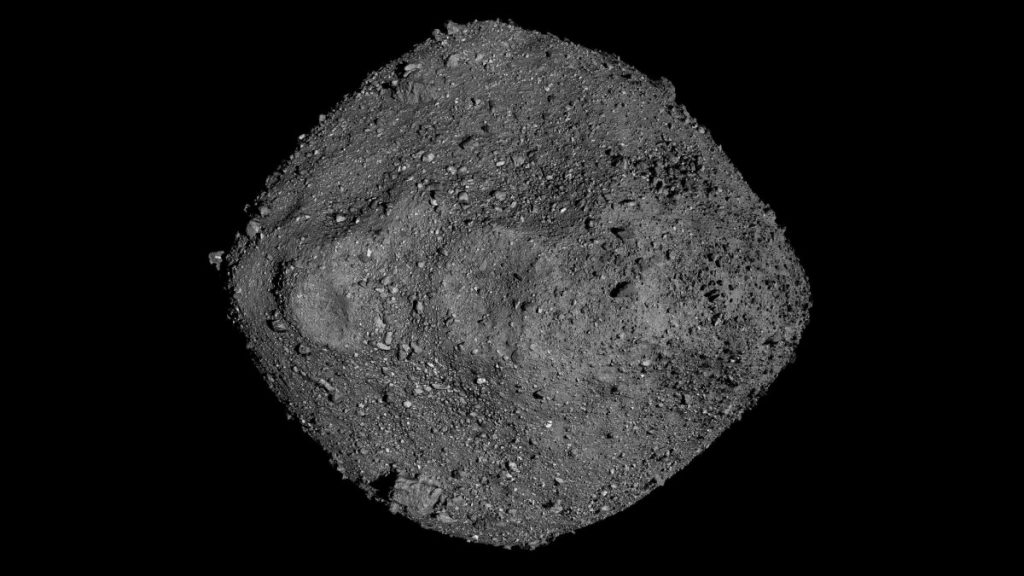
Asteroid Bennu is old before its time thanks to the sun (Image Credit: Space.com)
High-resolution images of surface cracks on the asteroid Bennu taken by NASA’s OSIRIS-REx mission have revealed that heat from the sun may age asteroids prematurely.
A team of scientists behind the OSIRIS-REx mission has discovered that heat from the sun created fractures on the asteroid over a period of 10,000 to 100,000 years. This is a much shorter period of time than astronomers previously believed this process would take, meaning surface regeneration on asteroids like Bennu could happen much more quickly than on Earth.
The discovery could help researchers estimate how long it takes large rocks on asteroids like Bennu to break down into smaller particle-like pieces which either remain on the space rock or could be ejected into space.
Related: Dramatic sampling shows asteroid Bennu is nothing like scientists expected
“We thought surface regeneration on asteroids took a few millions of years,” Marco Delbo, scientist at Université Côte d’Azur, said in statement. (opens in new tab) “We were surprised to learn that the aging and weathering process on asteroids happens so quickly, geologically speaking.”
Delbo led the research team that found rapid temperature changes on Bennu cause internal stress which, in turn, fractures and breaks rocks. NASA says the process is analogous to how a cold glass breaks when it is exposed to hot water.
OSIRIS-REx (its name is short for Origins-Spectral Interpretation-Resource Identification-Security-Regolith Explorer) arrived at Bennu in 2018 after a two-year journey to the asteroid which is believed to have formed between 700 million and 2 billion years ago. The images the craft took during its mission, which will be completed in 2023 when it returns to Earth (opens in new tab) with samples, reveal cracks in the surface that seem to point in the same northwest-southeast direction.

The team believes this correlation is a ‘distinct signature’ caused by the difference in temperature of the asteroid during its ‘day’ and ‘night.’
On Bennu, the sun rises every 4.3 Earth days and creates daytime temperatures that can be as high as around 260 degrees Fahrenheit (about 127 Celsius). At night, however, temperatures on the asteroid plummet as low as around minus 10 F (minus 23 C).
Thus, the observations of the lengths and angles of 1,500 cracks and fractures, some as small as a tennis racquet and others as long as a tennis court, show the sun to be the primary driver of geographic changes on Bennu.
“If landslides or impacts were moving boulders faster than the boulders were cracking, the fractures would point in random directions,” Delbo continues.
Though many geographic changes on Earth happen suddenly due to events like landslides, volcanoes, and earthquakes, other changes are gradual. Our planet and its neighbor Mars also experience thermal fracturing just like Bennu, but with a difference.
“The thermal fractures on Bennu are quite similar to what we find on Earth and on Mars in terms of how they form,” Université Côte d’Azur scientist and team member Christophe Matonti said in the statement. “It is fascinating to see that they can exist and are similar in very ‘exotic’ physical conditions [low gravity, no atmosphere] even compared to Mars.”
Because asteroids like Bennu are comprised of unspoiled material left over from the formation of the planets around 4.5 billion years ago, even studying an asteroid with a young topography like Bennu can reveal the conditions present in the early solar system.
“Keep in mind, the topography of Bennu is young, but the rocks on the asteroids are still billions of years old and hold valuable information about the beginning of the solar system,” OSIRIS-REx project scientist at NASA’s Goddard Space Flight Center (opens in new tab) in Greenbelt, Maryland, Jason Dworkin, said.
The team’s findings were published in the June edition of the journal Nature Geoscience. (opens in new tab)
Follow us on Twitter @Spacedotcom (opens in new tab) or on Facebook (opens in new tab).





